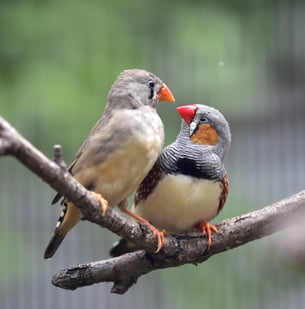Felix W. Moll and colleagues from Michael Long’s group at NYU recently published an outstanding paper in Nature titled “Thalamus drives vocal onsets in the zebra finch courtship song” featuring Diagnostic Biochips high-density silicon probes.
 In this set of studies, Moll et al investigated the role of the thalamus and associated projections in the execution of complex motor behaviors, such as zebra finch song production. Using a combination of in vivo two-photon imaging and electrophysiology, they were able to identify thalamic axons in the zebra finch song nucleus HVC demonstrating song-related activity. The results of HVC imaging and thalamic stimulation protocols in awake and head-fixed birds, together with song behavior, revealed that the activity of HVC neurons receiving thalamic input immediately preceded syllable onset. Collectively, these findings suggest that thalamocortical projections may serve as a “go cue” to initiate premotor sequences and associated behaviors.
In this set of studies, Moll et al investigated the role of the thalamus and associated projections in the execution of complex motor behaviors, such as zebra finch song production. Using a combination of in vivo two-photon imaging and electrophysiology, they were able to identify thalamic axons in the zebra finch song nucleus HVC demonstrating song-related activity. The results of HVC imaging and thalamic stimulation protocols in awake and head-fixed birds, together with song behavior, revealed that the activity of HVC neurons receiving thalamic input immediately preceded syllable onset. Collectively, these findings suggest that thalamocortical projections may serve as a “go cue” to initiate premotor sequences and associated behaviors.
Read the full paper here: https://www.nature.com/articles/s41586-023-05818-x
ABSTRACT: While motor cortical circuits contain information related to specific movement parameters, long-range inputs also have a critical role in action execution. Thalamic projections can shape premotor activity and have been suggested to mediate the selection of short, stereotyped actions comprising more complex behaviours8. However, the mechanisms by which thalamus interacts with motor cortical circuits to execute such movement sequences remain unknown. Here we find that thalamic drive engages a specific subpopulation of premotor neurons within the zebra finch song nucleus HVC (proper name) and that these inputs are critical for the progression between vocal motor elements (that is, ‘syllables’). In vivo two-photon imaging of thalamic axons in HVC showed robust song-related activity, and online perturbations of thalamic function caused song to be truncated at syllable boundaries. We used thalamic stimulation to identify a sparse set of thalamically driven neurons within HVC, representing ~15% of the premotor neurons within that network. Unexpectedly, this population of putative thalamorecipient neurons is robustly active immediately preceding syllable onset, leading to the possibility that thalamic input can initiate individual song components through selectively targeting these ‘starter cells’.
Our findings highlight the motor thalamus as a director of cortical dynamics in the context of an ethologically relevant behavioural sequence.
Learn more about the Long Lab and their innovative studies here: https://longlab.med.nyu.edu/research/
